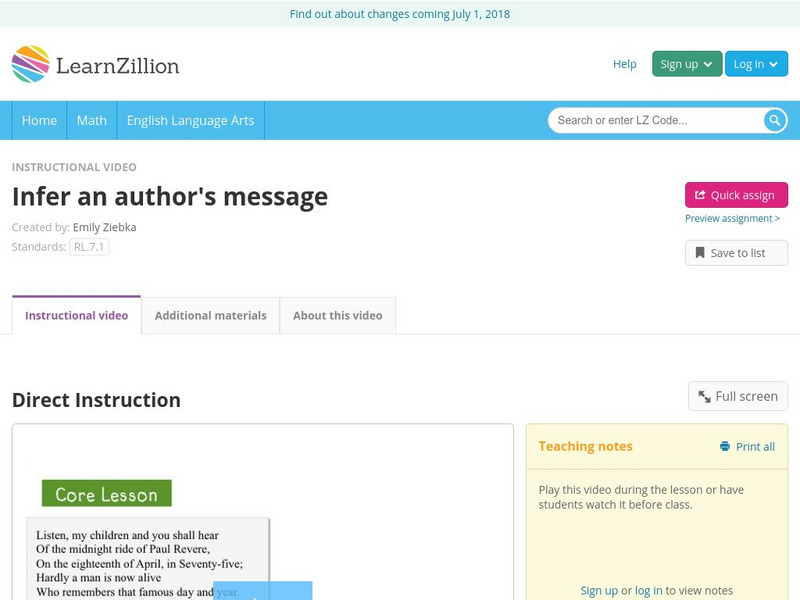Hi, what do you want to do?
PBS
One Hundred Years of Solitude | The Great American Read
One Hundred Years of Solitude introduces readers to magic realism. Told in a series of flashbacks and flash-forwards, Gabriel Garcia Marquez's Nobel Prize-winning novel is a candidate for The Great American Read program and aficionados...
PBS
And Then There Were None
Justice and murder are the heart of the best mysteries. The writers interviewed for this episode of the Great American Read try to convince viewers that the best of this genre is Agatha Christie's And Then There Were None.
PBS
1984 by George Orwell
Reverend Katrina Foster offers her rationale for why Winston Smith, the tragic hero of George Orwell's dystopian novel 1984, is her favorite literary character.
Lit2Go
The Serpent and the File
Teach readers about elements of a plot through Aesop's 70-word fable "The Serpent and the File." Scholars learn about useless attacking while reading the passage that tells how a serpent decides to engage in a conflict with a file. The...
Lit2Go
The Mole and His Mother
Mother knows best, according to Aesop and his fable "The Mole and his Mother." An audio retelling of the story comes with an activity that asks readers to research and describe a mole before outlining the plot structure of the fable.
Lit2Go
The Man and the Lion
The plot diagramming activity that accompanies Aesop's "The Man and the Lion" asks readers to investigate the relationship between parts of the plot and the moral of the story. The resource comes with an audiobook recording of the fable...
Lit2Go
The Flies and the Honeypot
Is temporary pleasure worth a lifetime of pain? A group of flies learns their unfortunate—and sticky—lesson with Aesop's fable "The Flies and the Honeypot." After listening to an audio version of the tale, class members map the plot...
Lit2Go
The Father and His Sons
What do a family and a bundle of sticks have in common? They can't be broken. After reading Aesop's "The Father and His Sons," pupils complete a graphic organizer that explores the cause/effect structure and theme of the story.
Lit2Go
The Fox and the Stork
Forget the Golden Rule! Aesop's fable "The Fox and the Stork" explores what happens when a stork, treated poorly at the fox's meal, hosts his own dinner. Learners listen to an audio version of the story before examining the causes and...
Lit2Go
The Boy Who Cried ‘Wolf'
Aesop's "The Boy Who Cried 'Wolf'" features a boy whose small mistake gets him into big trouble. What could have done differently? Learners make a concept map to depict the events from the fable after listening to an engaging audio...
Lit2Go
The Charcoal-Burner and the Fuller
Would a charcoal-burner make a good roommate? Read about the drawbacks of living with someone in the opposite profession with Aesop's "The Charcoal-Burner and the Fuller." A graphic organizer prompts learners to identify the beginning,...
Lit2Go
The Bats, the Birds, and the Beasts
Allegiance is about more than being on the winning side. Aesop's "The Bats, the Birds, and the Beasts" presents the conundrum that occurs when a bat seeks to join the side of the victors, and learns the consequences of his inaction....
Imagine Learning Classroom
Learn Zillion: Understand Figurative Language "On Thin Ice"
In this lesson, you will learn the meaning of the idiom, "on thin ice," by looking at a cartoon. [1:45]
Imagine Learning Classroom
Learn Zillion: Video: Determine Theme by Analyzing Repetition in a Poem
In this lesson, you will learn how to determine the theme of a poem by analyzing the author's use of repetition. [6:00]
Imagine Learning Classroom
Learn Zillion: Infer an Author's Message
In this lesson, you will learn how to make inferences about an author's message by looking at character development. A slideshow and student handout are included with site login. [7:43]
PBS
Pbs Learning Media: Literary Elements and Techniques: Theme
Learn how to identify theme in a literary work in this short animated video [2:26] from WNET.
PBS
Pbs Learning Media: Literary Elements and Techniques: Setting
Explore how authors use setting to establish the time, place, and social conditions in which a story takes place in this short animated video [2:38] from WNET.
Imagine Learning Classroom
Learn Zillion: Understand Figurative Language: "On the Fence"
In this lesson, you will learn the meaning of the idiom, "on the fence," by looking at a cartoon. [1:39]
Other
Flocabulary: The 5 Types of Text Structure
How do authors organize the texts they write? This musical video teaches five common text structures used in informational and nonfiction text: description, sequence, cause and effect, compare and contrast, and problem and solution. [3:49]
Imagine Learning Classroom
Learn Zillion: Understand Figurative Language: "Play It by Ear"
In this lesson, you will learn the meaning of the idiom, "play it by ear," by looking at a cartoon. [1:56]























